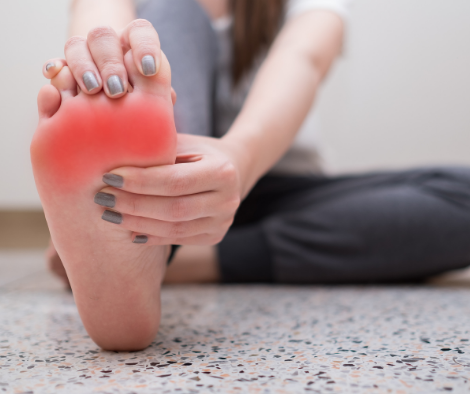Most runners will experience pain in the ball of their foot at some point in their running journey. This should be no surprise if you think about the substantial amount of pressure applied to this region when your foot contacts the ground and when you're pushing off. Pain in the ball of the foot can range from a niggle that makes running less enjoyable to more severe pain that stops you in your tracks.
Teaching you how to diagnose which structure the pain originates from is beyond this blog post's scope. There are so many structures in a relatively small space, and it isn't uncommon for multiple structures to be irritated simultaneously. Also, it has taken our podiatrists at least four years of university study and years of clinical experience to master the assessment and diagnosis of forefoot pain, so a blog post isn't going to get you up to scratch. However, I can teach you how to work out if the pain originates from soft tissue or bone, some simple things you can do to help yourself and when you should get the ball of your foot checked out by an expert.
Soft tissue injuries in the ball of the foot
As mentioned, there are lots of soft tissue structures in the ball of the foot, including muscle, tendon, fascia, ligament, joint capsule, nerve and bursa. So while the nature of the pain will typically vary according to the structure it's originating from, when you experience the pain and how it's affected by weight-bearing activity will usually be similar.
Typical day-to-day pain pattern
Sore and/or stiff when getting out of bed in morning
Gradually warms up
Symptoms return when walking after sitting
Symptoms return later in day after spending time on feet
Typical running pain pattern
Symptoms present at beginning
Gradually warms up
Symptoms may return towards end
Symptoms may be present throughout run as gets worse
Symptoms may be present for couple of hours up to couple of days after walk/run
Bone injuries in the ball of the foot
There are five long metatarsal bones in the ball of each foot (highlighted in blue below). The first metatarsal bone is the strongest and thus less prone to overuse injury. There are also two sesamoid bones underneath the end of the first metatarsal bones, which are prone to taking a long time to heal or not healing if a bone stress injury diagnosis is delayed. Bone stress injuries sit on a continuum, starting with a mild injury (e.g. irritation/inflammation) and progressing towards more severe injuries with longer recovery times (e.g. stress fracture).
Typical pain pattern
Irritation/inflammation
May start off similar to soft tissue symptoms
Stress reaction
Pain gets worse with continued weight-bearing activity
Pain becoming more localised
Stress fracture
Pain gets much worse with continued weight-bearing activity
Usually unable to push through
Pain will generally be very localised
May be some swelling and/or night pain
As you can see, there is usually quite a big difference between the pain pattern of a soft tissue and bone injury. That said, it's important to highlight that a more severe soft tissue injury could present similarly to a bone injury.
What should you do if you have pain in the ball of your foot?
Use the information above to work out if the pain is likely to be originating from a soft tissue structure or bone.
If you think you've got a stress fracture, you should seek assistance immediately. I love running, and I hate asking my patients to run less, but trying to run through a stress fracture is a terrible idea and could have both short and long-term implications for your running career. Even if you've got a more severe soft tissue injury, there's a good chance that it won't get better without treatment. The sooner you seek help, the sooner you'll get back to running.
If you think you've got a soft tissue injury, it's probably safe to continue running through it while you try to work out what's going on and make the necessary adjustments. Below are some things that you should consider, as making an adjustment could be all that's required to get you back to pain-free running.
Above I have explained the common pain patterns of soft tissue and bone injuries in the ball of the foot. You also need to consider how your training, footwear, general health and wellbeing influence the pain you're experiencing.
Training
Have you recently started running more?
Did the pain develop shortly afterwards?
Is there a chance that you increased your running training load too rapidly?
If yes, it'd be worthwhile reducing your running training load to see if it helps. Doing this is better than taking a break from running!
Is the pain worse during or after a particular training session? (e.g. after an interval or hill session)
If yes, it'd be worthwhile doing less of that type of session to see if it helps.
Is the pain worse when you run on consecutive days?
If yes, it'd be worthwhile adding in a rest day or cross-training day to see if it helps.
Are you running the same amount but doing a lot more incidental weight-bearing activity?
If yes, it'd be worthwhile trying to reduce your weight-bearing activity so that you're feeling as fresh as possible for your runs.
Footwear
Is there a chance that your runners are worn out?
It can be hard to tell by looking at them, but if you're more aware of your legs and feet while running than you used to be, there's a decent chance that your runners are worn out. This is even more likely if you've run 600-800 km in them. If you don't use your runners exclusively for running, they'll probably wear out before you get to the 600-800 km mark.
Do your runners feel a bit tight?
Has this become more noticeable as you've started to run more in them?
Runners that don't fit well are one of the most common causes of pain in the ball of the foot. Of all the shoes you wear, you're most likely to be able to find a pair of runners that fit well and feel comfortable.
Have you recently started running in a new pair of runners?
If so, your feet may still be adapting to them, particularly if you're running a lot or they're different to your last pair of runners. However, if they don't feel right after a couple of weeks, you should seek some advice.
If you need a new pair of runners, look no further than The Running Company in Clifton Hill. We trust them to help you select a new pair of runners that fit well, feel comfortable and complement your foot function.
General health and wellbeing
Have you recently been diagnosed with a medical condition, or has a pre-existing medical condition worsened recently?
Have you been more stressed, eating less or differently, or having difficulty getting a good night's sleep recently?
While running can positively impact some of these things, you can't ignore the fact that they can reduce your body's ability to cope with the demands of running and increase your risk of injury. Some of these things can't be changed easily, but you need to start somewhere.
Summary
If you decide to run through pain in the ball of your foot, pick a date two or three weeks down the track to work towards. If the pain hasn't reduced in severity and frequency by this time, it's time to get some help. Regardless of the source of the pain, running through it for months is likely to make it more challenging to overcome the issue and increase the likelihood that you'll need to reduce your running training load for longer than you'd like. If the pain increases in severity and frequency and you're taking longer to recover from each session before the date you've selected, get some help sooner.
Our experienced podiatrists are keen runners and thus have a special interest in helping people of all ages and abilities to overcome running-related injuries. So if the pain in the ball of your foot is making running and life less enjoyable, get in touch or book an appointment online today.
Author: Shaun Bergin


